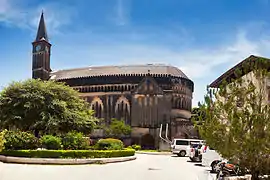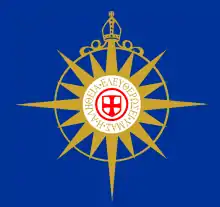Anglican Church of Tanzania
The Anglican Church of Tanzania (ACT) is a province of the Anglican Communion based in Dodoma. It consists of 28 dioceses (27 on the Tanzanian mainland, and 1 on Zanzibar) headed by their respective bishops. It seceded from the Province of East Africa in 1970, which it shared with Kenya. The current primate and archbishop is Maimbo Mndolwa, enthroned on 20 May 2018.[1]
| Anglican Church of Tanzania | |
|---|---|
 | |
| Primate | Maimbo Mndolwa |
| Polity | Episcopal |
| Headquarters | Dodoma, Tanzania |
| Territory | Tanzania |
| Members | 2,500,000 |
Official name
The Church became part of the Province of East Africa in 1960. From 1970 until 1997, it was known as the Church of the Province of Tanzania. Today it is known as the Anglican Church of Tanzania, or ACT.
History

Tanganyika
The church's origins lie in the Diocese of Eastern Equatorial Africa (Uganda, Kenya, Tanzania) founded in 1884, with James Hannington as the first bishop; however, Anglican missionary activity had been present in the area since the Universities' Mission to Central Africa and the Church Missionary Society began their work in 1864 and 1878 at Mpwapwa. In 1898, the diocese was split into two, with the new diocese of Mombasa governing Kenya and northern and Central Tanzania (the other diocese later became the Church of Uganda); northern and central Tanzania was separated from the diocese in 1927 when the Diocese of Central Tanganyika covering two thirds of Tanzania was created with its See at Dodoma. The first bishop was George "Jerry" Chambers, consecrated in 1927.[2] William (Bill) Wynn-Jones was the second bishop of Central Tanganyika.[3] In 1955, the diocese's first African bishops, Kenyans Festo Olang' and Obadiah Kariuki, and Tanzanian (Tanganyikan) Yohana Omari were consecrated by the Archbishop of Canterbury, Geoffrey Fisher, in Uganda as assistant bishops. In 1964, John Sepeku became bishop of the newly-divided Diocese of Dar es Salaam (having previously been assistant bishop of Zanzibar).[4] (Olang as well as Sepeku would be elected the first African archbishops in 1970). In 1960, the province of East Africa, comprising Kenya and Tanzania, was formed with Leonard Beecher as first archbishop. The province of East Africa was divided in two, Kenya and Tanzania, in 1970 and the province of Tanzania was formed with John Sepeku as the first archbishop. By 1962, Musa Kahurananga was Assistant Bishop of Central Tanganyika;[5] in 1964, Yohana Madinda took on the same post.[4]
Zanzibar

The Diocese of Zanzibar was founded in 1892, and developed separately from that of Eastern Equatorial Africa. Whilst mainland Tanzania was largely under the influence of evangelical missionary societies, Zanzibar was evangelised by Anglo-catholic missionaries, and represented a far more high church form of Anglicanism. The mainland territories and Zanzibar were united when the Province of East Africa was formed.
The first bishop of Zanzibar was Charles Smythies, who was translated from his former post as Bishop of Nyasaland in 1892. Zanzibar Cathedral, located in Stone Town, Zanzibar City, is a prominent landmark, and a national heritage asset. Historically the diocese included mainland locations in Tanganyika, and In 1963 it was renamed as the Diocese of Zanzibar & Dar es Salaam. Two years later, in 1965, Dar es Salaam became a separate diocese, and the original was again renamed as the Diocese of Zanzibar & Tanga. In 2001 the mainland links were finally ended, and the name reverted to the original Diocese of Zanzibar. The diocese continues to include the neighbouring island of Pemba. There have been ten bishops of the diocese from 1892 to the present day.
Having fallen into poor condition, Zanzibar Cathedral was fully restored, at a cost of one million Euros, to reopen in 2016, with a world heritage visitor centre. The restoration was supported by the Tanzanian and Zanzibari governments, and spearheaded by the diocese in partnership with the World Monuments Fund.[6] The restoration of the spire, clock, and historic Willis organ are still outstanding.
Membership
Today, there are at least 2,500,000 Anglicans out of an estimated population of 34,500,000 in Tanzania.
Independent associations open to members of the church include the Mothers' Union (MU), the Tanzania Anglican Youth Organization (TAYO) and the Anglican Evangelistic Association (AEA).
Among the Church's prominent educational institutions are the newly founded St. John's University of Tanzania based in Dodoma, as well as the two Provincial Theological Colleges, St. Phillip's located at Kongwa, and St Mark's in Dar es Salaam).
The Central Tanganyika Press (CTP) and the Literature Organization (SKM, also known as the Dar es Salaam Bookshop), are autonomous church institutions with a prominent role in Anglican church life.
Structure
In common with other Anglican churches the Anglican Church of Tanzania has Episcopal polity. The Archbishop of Tanzania is both Metropolitan and Primate of the church. The church maintains a system of geographical parishes organized into dioceses. There are currently 28 dioceses, each headed by a diocesan bishop.
Dioceses
Archbishops
The Primate of the Church is the Archbishop of Tanzania. The See of the archbishop was formerly fixed at Dodoma, but is now non-geographical. Whichever bishop is elected as Primate remains bishop of his own diocese, as well as becoming Archbishop of Tanzania. There have been seven archbishops since the Province of East Africa was divided into the Provinces of Kenya and Tanzania in 1970.[7]
- 1970–1978: John Sepeku, Bishop of Dar es Salaam
- 1979–1983: Mussa Kahurananga
- 1984–1998: John Ramadhani
- 1998–2008: Donald Mtetemela
- 2008–2013: Valentino Mokiwa
- 2013–2018: Jacob Chimeledya
- 2018–present: Maimbo Mndolwa
Other bishops
Alfred Stanway (called Alf; 9 September 1908 – 27 June 1989) was the third bishop of Central Tanganyika, 1951–1971.[8] He was made a deacon on St Thomas' Day 1934 (21 December) in St Paul's Cathedral, Melbourne,[9] ordained a priest about a year later, and consecrated a bishop on Candlemas 1951 (2 February) by Geoffrey Fisher, Archbishop of Canterbury, at Westminster Abbey.[10]
Doctrine and practice
The Anglican Church of Tanzania embraces the three traditional orders of ministry: deacon, priest, and bishop. A local variant of the Book of Common Prayer is used.
The center of the Anglican Church of Tanzania teaching is the life and resurrection of Jesus Christ. The basic teachings of the church, or catechism, includes:
- Jesus Christ is fully human and fully God. He died and was resurrected from the dead.
- Jesus provides the way of eternal life for those who believe.
- The Old and New Testaments of the Bible were written by people "under the inspiration of the Holy Spirit". The Apocrypha are additional books that are used in Christian worship, but not for the formation of doctrine.
- The two great and necessary sacraments are Holy Baptism and Holy Eucharist
- Other sacramental rites are confirmation, ordination, marriage, reconciliation of a penitent, and unction.
- Belief in heaven, hell, and Jesus's return in glory.
The threefold sources of authority in Anglicanism are scripture, tradition, and reason. These three sources uphold and critique each other in a dynamic way. This balance of scripture, tradition and reason is traced to the work of Richard Hooker, a sixteenth-century apologist. In Hooker's model, scripture is the primary means of arriving at doctrine and things stated plainly in scripture are accepted as true. Issues that are ambiguous are determined by tradition, which is checked by reason.[11]
Ecumenical relations
Like many other Anglican churches, the Anglican Church of Tanzania is a member of the ecumenical World Council of Churches.[12]
Anglican realignment
In December 2006 the ACT declared itself to be in "impaired communion" with The Episcopal Church (US) over the ordination of non-celibate gay people and the blessing of same-sex unions. The ACT is a member of the Global South and the Fellowship of Confessing Anglicans, and has been a part of the Anglican realignment. Archbishop Valentino Mokiwa attended GAFCON in Jerusalem, in June 2008, and supported the inception of the Anglican Church in North America, in June 2009. Archbishop Jacob Chimeledya, an evangelical and orthodox Anglican, was perceived by some to have moved the ACT more into the "reconciliation" ground, as is being promoted by Archbishop of Canterbury Justin Welby, moving away from GAFCON. The ACT was represented at GAFCON II in Nairobi, in 21–16 October 2013, by former Archbishop Donald Mtetemela and other bishops. The ACT House of Bishops meeting, held in Dodoma, on 12–13 April 2016, voted to rejoin the GAFCON movement and to authorize Jacob Chimeledya to attend GAFCON's Primates council in Nairobi the same month, which he did.[13]
The ACT was represented at GAFCON III, in Jerusalem, on 17–22 June 2018, by a 26 members delegation, which included former Archbishop Jacob Chimeledya. Archbishop Maimbo Mndolwa was registered to attend but wasn't able to come.[14]
The official branch of GAFCON Tanzania was launched on 14 August 2019, in a meeting held in Dar es Salaam, that reunited 10 bishops of the province, including former Archbishop Jacob Chimeledya, and had the support of one more absent bishop and the retired Archbishop Donald Mtetemela. The bishops represented agreed not the attend the Lambeth Conference in 2020, due to the Archbishop of Canterbury unwillingness in discipline the provinces that have rejected the Lambeth 1.10 1998 resolution on human sexuality. Bishop Mwita Akiri was elected branch chairman on the occasion. Current Archbishop Maimbo Mndolwa, despite having signed the Jerusalem Declaration, hasn't declared yet his formal support for GAFCON Tanzania.[15]
References
- "I will be Maimbo" - New Primate of Tanzania honours past as he ushers in new era, Anglican Communion News Service, 21 May 2018
- Markham, Ian S.; Barney Hawkins, IV, J.; Terry, Justyn; Nuñez Steffensen, Leslie (2013). The Wiley-Blackwell Companion to the Anglican Communion. John Wiley & Sons. pp. 255–. ISBN 978-1-118-32086-0.
- "NEW BISHOP APPOINTED". The Sydney Morning Herald. 23 July 1947. p. 4.
- "Retrospect of 1964". Church Times (#5316). 1 January 1965. p. 16. ISSN 0009-658X. Retrieved 4 September 2019 – via UK Press Online archives.
- "Black bishops and white in Africa". Church Times (#5193). 24 August 1962. p. 13. ISSN 0009-658X. Retrieved 28 August 2019 – via UK Press Online archives.
- Progress report and photographs at this Archived 2017-06-28 at the Wayback Machine webpage.
- Markham, Ian S.; Hawkins, J. Barney; Terry, Justyn; Steffensen, Leslie Nuñez (2013). The Wiley-Blackwell Companion to the Anglican Communion. John Wiley and Sons. ISBN 9781118320860. Retrieved 28 November 2014.
- "Stanway, Alfred". Who's Who. ukwhoswho.com. A & C Black, an imprint of Bloomsbury Publishing plc. (subscription or UK public library membership required)
- "Consecations in two provinces". Church Times (#4592). 9 February 1951. p. 108. ISSN 0009-658X. Retrieved 6 November 2019 – via UK Press Online archives.
- Anglican Listening Archived July 5, 2008, at the Wayback Machine Detail on how scripture, tradition, and reason work to "uphold and critique each other in a dynamic way".
- http://www.oikoumene.org/?id=3587 World Council of Churches
- Tanzania rejoins GAFCON, Anglican Ink, 19 April 2016
- GAFCON III largest pan-Anglican gathering since Toronto Congress of 1963, Anglican Ink, 20 June 2018
- Communiqué from Gafcon Tanzania, 14 August 2019, GAFCON Official Website
Further reading
- Anglicanism, Neill, Stephen. Harmondsworth, 1965.
